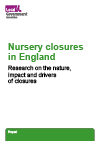The Local Government Association commissioned Isos Partnership in November 2022 to undertake a short research project. The aim has been to better understand the trends, impacts and drivers of recent private and voluntary sector nursery closures, and consider the local and national implications.
Executive summary
There has been a lot of media attention, and reports from sector-led bodies, about growing levels of nursery closures since the pandemic. These have been echoed in declining confidence amongst local authorities about ‘sufficiency’ of provision to deliver funded childcare entitlements and meet the needs of working families, as reported in the 2023 Coram childcare survey.
So what is really going on now, how different is it to the past, and how concerned should we be for the future? With these questions in mind, the Local Government Association commissioned Isos Partnership in November 2022 to undertake a short research project. The aim has been to better understand the trends, impacts and drivers of recent private and voluntary sector nursery closures, and consider the local and national implications.
The Chancellor’s announcement in March 2023 of 30 hours of free childcare for every child with working parents aged from nine months to five years puts a significant premium on understanding these issues. If successful, the policy could raise parental demand for nursery places substantially, potentially benefitting significant numbers of children and families. But this will depend on securing enough good-quality places. Sector bodies remain concerned that the promised increase in funding from September will be too little too late, and that the entitlement extension itself, if not properly funded, could risk further closures and reduce capacity.
The Chancellor’s new ambition to extend the entitlement to provider-funded childcare aims to radically improve childcare access and affordability for families with young children. The plan is that from September 2025 all children aged between nine months and five years with working parents will be able to access 30 hours of free provision per week, with roll-out to all two-year-olds beginning in spring 2024.
The starting context, however, is an escalation of reports of strain across the early years sector and questions about existing capacity. Since the pandemic, rising costs, reduced real-terms funding rates1 and workforce pressures are said to be forcing up fees and threatening provision across the country.2 The impression is that the long-term decline in childminders is spreading to closures of private and voluntary nurseries, where a far greater proportion of children attend provision. When nursery closures happen, media stories abound about upheaval for children and parents struggling to find accessible and affordable alternatives.3 This picture was reflected in the Coram 2023 childcare survey, which showed a decline in the number of local authorities feeling confident about whether they have sufficient provision, with only half of local areas saying they have enough childcare for children under two.4
This is not the first time that the alarm has been raised on childcare – funding levels have long been challenged and past ‘crises’ have not always come to pass. So what is really going on now, how different is it to the past, and how concerned should we be for the future? With these questions in mind, the Local Government Association commissioned Isos Partnership in November 2022 to undertake a short research project to better understand the trends, impacts and drivers of private and voluntary sector nursery closures, and consider the implications.
The research was commissioned and largely conducted prior to the budget announcement, but the new commitment puts a significant premium on the need to grasp these issues better. If successful, the policy could raise parental demand for nursery places substantially, potentially benefitting significant numbers of children and families. But this will depend on securing enough good-quality places. The government has promised a rise in the rate of funding from September 2023, but whether it will be sufficient remains an open question (at the point of writing all that is known is that it should be enough to protect total spending in real terms over the next few years, with a 30 per cent increase in the rate for two-year-olds). Sector bodies fear that the increase will be ‘too little, too late’, and if the rate does not fully cover delivery costs, the expansion could lead to further closures by encroaching on the space for settings to cross-subsidise through charges to parents for provision outside funded entitlements, as many currently do.
This report summarises Isos’s brief investigation, setting out the work they have undertaken and the background context in terms of mixed market, long-term trends and the contribution of private and voluntary sector nurseries. It then goes on to describe Isos’s findings about the nature of recent closures , including most recent trends, the types of setting closing and location and interaction with deprivation. The next section brings together insights on the impacts on children, families and communities and why some are more affected than others, local authorities’ role in mitigating impacts and the outlook on sufficiency. The following sections explore the drivers of recent closures and why some settings are more at risk, drawing heavily on our fieldwork. Finally, included are reflections and recommendations, considering actions at the local authority and national level.

- Published by:
-
LGA
- Reference code:
-
15.122
